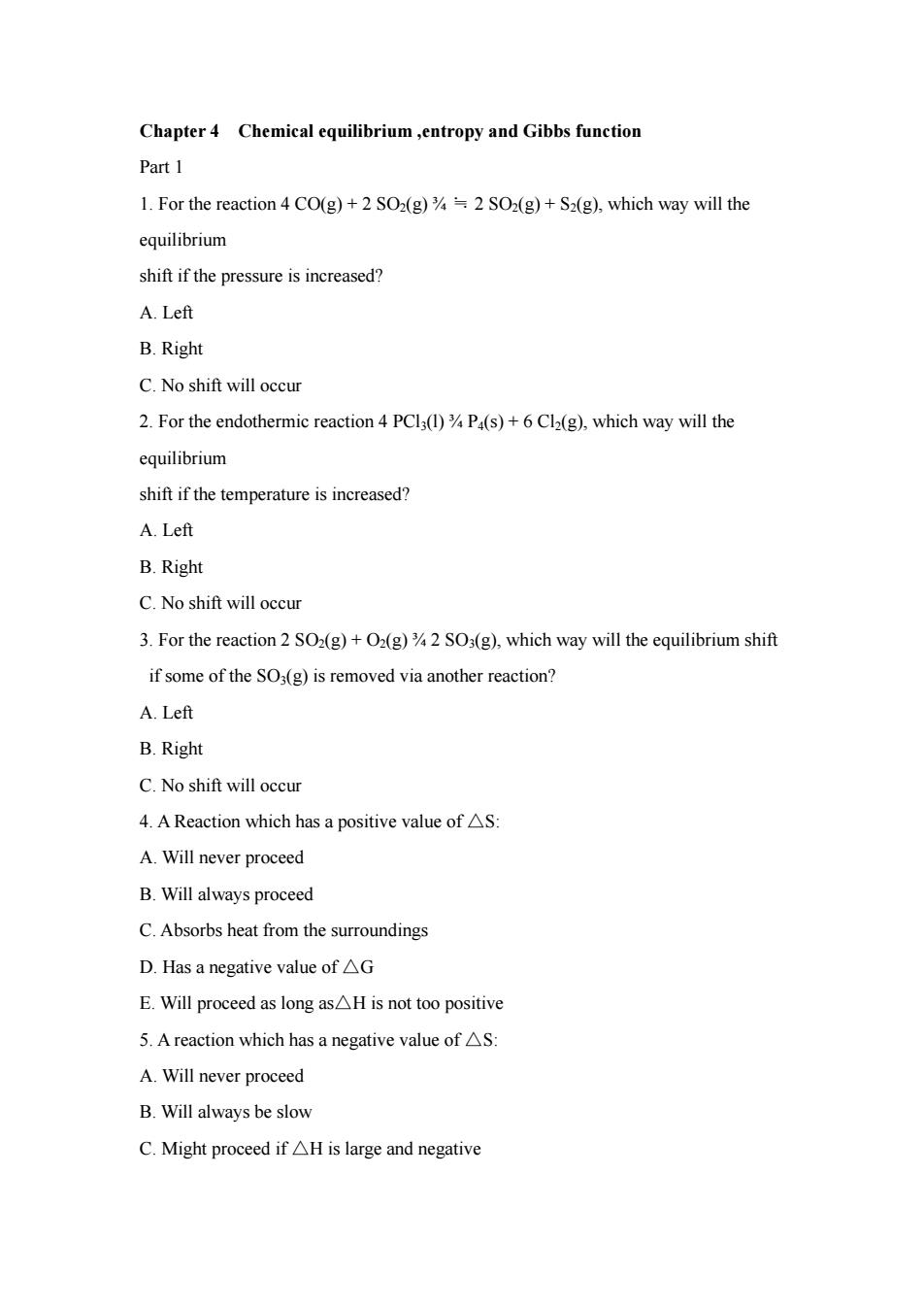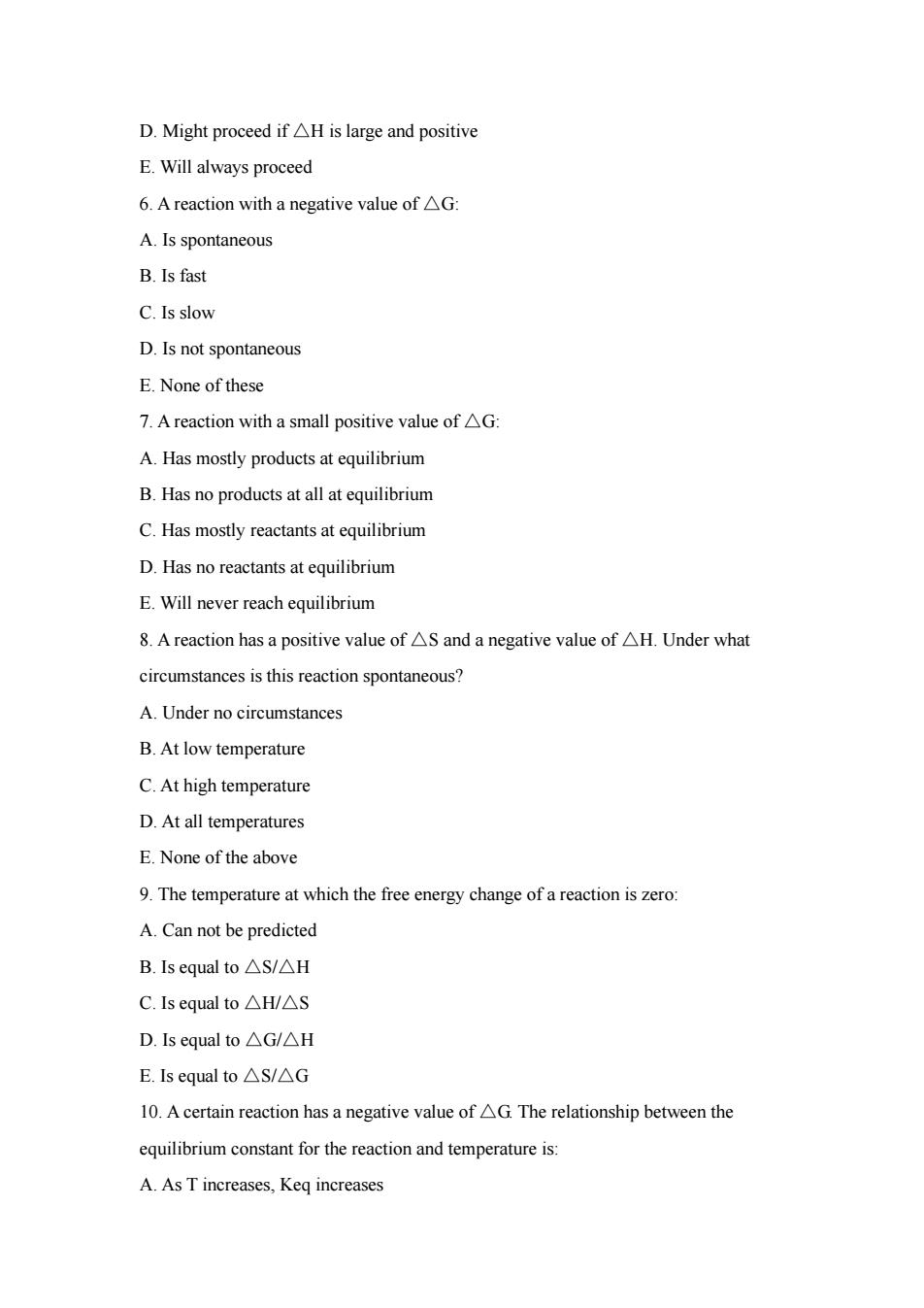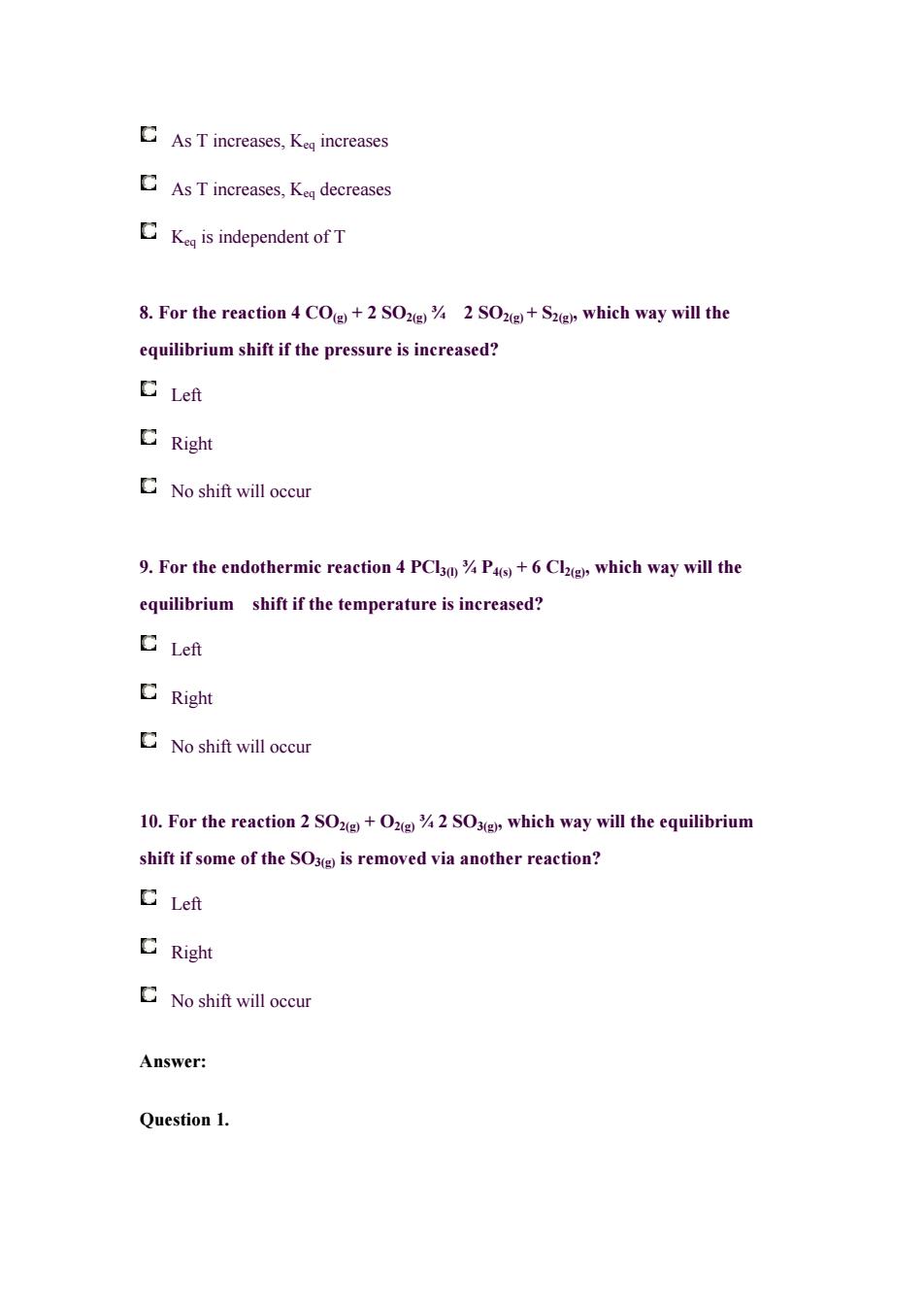
Chapter 4 Chemical equilibrium,entropy and Gibbs function Part 1 1.For the reaction 4 CO(g)+2 SO2(g)2 SO2(g)+S2(g),which way will the equilibrium shift if the pressure is increased? A.Left B.Right C.No shift will occur 2.For the endothermic reaction 4 PCl(1)%P(s)+6Cl(g),which way will the equilibrium shift if the temperature is increased? A.Left B.Right C.No shift will oceur 3.For the reaction 2 SO2(g)+O2(g)2 SO3(g),which way will the equilibrium shift if some of the SO (g)is removed via another reaction? A.Left B.Right C.No shift will occur 4.A Reaction which has a positive value of S: A.Will never proceed B.Will always proceed C.Absorbs heat from the surroundings D.Has a negative value of AG E.Will proceed as long asH is not too positive 5.A reaction which has a negative value ofAS A.Will never proceed B.Will always be slow C.Might proceed ifH is large and negative
Chapter 4 Chemical equilibrium ,entropy and Gibbs function Part 1 1. For the reaction 4 CO(g) + 2 SO2(g) ¾ ≒ 2 SO2(g) + S2(g), which way will the equilibrium shift if the pressure is increased? A. Left B. Right C. No shift will occur 2. For the endothermic reaction 4 PCl3(l) ¾ P4(s) + 6 Cl2(g), which way will the equilibrium shift if the temperature is increased? A. Left B. Right C. No shift will occur 3. For the reaction 2 SO2(g) + O2(g) ¾ 2 SO3(g), which way will the equilibrium shift if some of the SO3(g) is removed via another reaction? A. Left B. Right C. No shift will occur 4. A Reaction which has a positive value of △S: A. Will never proceed B. Will always proceed C. Absorbs heat from the surroundings D. Has a negative value of △G E. Will proceed as long as△H is not too positive 5. A reaction which has a negative value of △S: A. Will never proceed B. Will always be slow C. Might proceed if △H is large and negative

D.Might proceed if AH is large and positive E.Will always proceed 6.A reaction with a negative value of G: A.Is spontaneous B.Is fast C.Is slow D.Is not spontaneous E.None of these 7.A reaction with a small positive value of AG: A.Has mostly products at equilibrium B.Has no products at all at equilibrium C.Has mostly reactants at equilibrium D.Has no reactants at equilibrium E.Will never reach equilibrium 8.A reaction has a positive value of S and a negative value of H.Under what circumstances is this reaction spontaneous? A.Under no circumstances B.At low temperature C.Athigh temperature D.At all temperatures E.None of the above 9.The temperature at which the free energy change of a reaction is zero A.Can not be predicted B.Is equal to△S/△H C.Is equal to△HW△S D.Is equal to△G/△H E.Is equal to△S/△G 10.A certain reaction has a negative value of AG The relationship between the equilibrium constant for the reaction and temperature is A.AsTincreases,Keq increases
D. Might proceed if △H is large and positive E. Will always proceed 6. A reaction with a negative value of △G: A. Is spontaneous B. Is fast C. Is slow D. Is not spontaneous E. None of these 7. A reaction with a small positive value of △G: A. Has mostly products at equilibrium B. Has no products at all at equilibrium C. Has mostly reactants at equilibrium D. Has no reactants at equilibrium E. Will never reach equilibrium 8. A reaction has a positive value of △S and a negative value of △H. Under what circumstances is this reaction spontaneous? A. Under no circumstances B. At low temperature C. At high temperature D. At all temperatures E. None of the above 9. The temperature at which the free energy change of a reaction is zero: A. Can not be predicted B. Is equal to △S/△H C. Is equal to △H/△S D. Is equal to △G/△H E. Is equal to △S/△G 10. A certain reaction has a negative value of G. The relationship between the △ equilibrium constant for the reaction and temperature is: A. As T increases, Keq increases

B.AsTincreases,Keq decreases C.Keq is independent ofT Part 2 1.A Reaction which has a positive value of S: Will never proceed Will always proceed Aborbs heat from the surroundings Has a negative value of G Will proceed asong as Hisnot too positive 2.A reaction which has a negative value of S: Will never proceed CWill always be slow Might proceed if Hislarge and negative Might proced if Hislarge and positive Will always proceed 3.A reaction with a negative value of G: CIs spontaneous 口Is fast C Is slow Is not spontaneous CNone of these
B. As T increases, Keq decreases C. Keq is independent of T Part 2 1. A Reaction which has a positive value of S: Will never proceed Will always proceed Absorbs heat from the surroundings Has a negative value of G Will proceed as long as H is not too positive 2. A reaction which has a negative value of S : Will never proceed Will always be slow Might proceed if H is large and negative Might proceed if H is large and positive Will always proceed 3. A reaction with a negative value of G: Is spontaneous Is fast Is slow Is not spontaneous None of these

4.A reaction with a small positive value of G: Has mostly products at equilibrium Haso products at all Has mostly reactants at equilibrium Has no reactants aquibrum Will never reach equilibrium 5.A reaction has a positive value of S and a negative value of H.Under what circumstances is this reaction spontaneous Under no circumstances CAt low temperature At high temperature CAt all temperatures None of the above 6.The temperature at which the free energy change of a reaction is zero: Can not be predicted CIs equal to S/H Is equal to H/S Is equal to G/H Is equal to S/G 7.A certain reaction has a negative value of G.The relationship between the equilibrium constant for the reaction and temperature is:
4. A reaction with a small positive value of G: Has mostly products at equilibrium Has no products at all at equilibrium Has mostly reactants at equilibrium Has no reactants at equilibrium Will never reach equilibrium 5. A reaction has a positive value of S and a negative value of H. Under what circumstances is this reaction spontaneous? Under no circumstances At low temperature At high temperature At all temperatures None of the above 6. The temperature at which the free energy change of a reaction is zero: Can not be predicted Is equal to S/ H Is equal to H/ S Is equal to G/ H Is equal to S/ G 7. A certain reaction has a negative value of G. The relationship between the equilibrium constant for the reaction and temperature is:

AsT increases,K increases CAsTincreases,K decreases Kis independent ofT 8.For the reaction 4 CO+2 SOzg 2 SO2+Szgr which way will the equilibrium shift if the pressure is increased? C Left CRight No shift will occur 9.For the endothermic reaction 4 PClso%Pas)+6 Cli)which way will the equilibrium shift if the temperature is increased? C Left CRight No shift will occur 10.For the reaction 2 SO+2 SO which way will the equilibrium shift if some of the SO is removed via another reaction? C Left CRight No shift will occur Answer: Question 1
As T increases, Keq increases As T increases, Keq decreases Keq is independent of T 8. For the reaction 4 CO(g) + 2 SO2(g) ¾ 2 SO2(g) + S2(g), which way will the equilibrium shift if the pressure is increased? Left Right No shift will occur 9. For the endothermic reaction 4 PCl3(l) ¾ P4(s) + 6 Cl2(g), which way will the equilibrium shift if the temperature is increased? Left Right No shift will occur 10. For the reaction 2 SO2(g) + O2(g) ¾ 2 SO3(g), which way will the equilibrium shift if some of the SO3(g) is removed via another reaction? Left Right No shift will occur Answer: Question 1

As long as DH is not too positive,then the free energy change will be negative,and the reaction will be spontaneous. Question2. Exothermic reactions have negative values of DH. Question 4. Since DG is positive,there are mostly reactants left at equilibrium. Question5. Such a reaction is spontaneous at all temperatures.DH and DS are both favorable Question 6. When the system is at equilibrium,DG=0=DH-T DS.Thus,T=DH/DS. Question 7. If DG is negative,then as T increases,Keq decreases Question 8. The equilibrium will shift right,towards a smaller number of moles. Question9. The equilibrium shifts in the endothermic direction(right!) Question 10. The equilibrium will shift so as to replace the SO3(i.e.to the right)
As long as DH is not too positive, then the free energy change will be negative, and the reaction will be spontaneous. Question 2. Exothermic reactions have negative values of DH. Question 4. Since DG is positive, there are mostly reactants left at equilibrium. Question 5. Such a reaction is spontaneous at all temperatures. DH and DS are both favorable. Question 6. When the system is at equilibrium, DG = 0 = DH - T DS. Thus, T = DH/DS. Question 7. If DG is negative, then as T increases, Keq decreases. Question 8. The equilibrium will shift right, towards a smaller number of moles. Question 9. The equilibrium shifts in the endothermic direction (right!). Question 10. The equilibrium will shift so as to replace the SO3 (i.e. to the right)